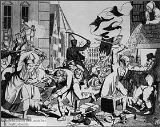
Pogrom
Overview
Riot
A riot is a form of civil disorder characterized often by what is thought of as disorganized groups lashing out in a sudden and intense rash of violence against authority, property or people. While individuals may attempt to lead or control a riot, riots are thought to be typically chaotic and...
, a mob attack directed against a minority group, and characterized by killings and destruction of their homes and properties, businesses, and religious centres. It originally and still typically refers to 19th and 20th century attacks on Jews
Jews
The Jews , also known as the Jewish people, are a nation and ethnoreligious group originating in the Israelites or Hebrews of the Ancient Near East. The Jewish ethnicity, nationality, and religion are strongly interrelated, as Judaism is the traditional faith of the Jewish nation...
, particularly in the Russian Empire
Russian Empire
The Russian Empire was a state that existed from 1721 until the Russian Revolution of 1917. It was the successor to the Tsardom of Russia and the predecessor of the Soviet Union...
.
Famous pogroms include the Odessa pogroms, Warsaw pogrom (1881)
Warsaw pogrom (1881)
The Warsaw pogrom was a pogrom that took place in Russian-controlled Warsaw on December 25–27, 1881, then part of Vistula Land in the Russian Empire.-Warsaw Pogrom:...
, Kishinev pogrom
Kishinev pogrom
The Kishinev pogrom was an anti-Jewish riot that took place in Chişinău, then the capital of the Bessarabia province of the Russian Empire on April 6-7, 1903.-First pogrom:...
(1903), Kiev Pogrom (1905)
Kiev Pogrom (1905)
The Kiev pogrom of October 18-October 20 came as a result of the collapse of the city hall meeting of October 18, 1905 in Kiev in the Russian Empire. Consequently, a mob was drawn into the streets...
, Białystok pogrom
Białystok pogrom
The Białystok pogrom occurred between 14–16 June 1906 in Białystok, then part of the Russian Empire, now in Poland. During the pogrom between 81 and 88 people were killed, and about 80 people were wounded....
(1906), Lwów pogrom (1918)
Lwów pogrom (1918)
The Lwów pogrom of the Jewish population of Lwów took place on November 21–23, 1918 during the Polish-Ukrainian War. In the course of the three days of unrest in the city, an estimated 52-150 Jewish residents were murdered and hundreds injured, with widespread looting carried out by Polish...
, and Kiev Pogroms (1919)
Kiev Pogroms (1919)
The Kiev pogroms of 1919 refers to a series of Jewish pogroms in various places around Kiev carried out by Cossacks, the White Armies, and the small percentage of Bolsheviks...
. Notorious pogroms of World War II
World War II
World War II, or the Second World War , was a global conflict lasting from 1939 to 1945, involving most of the world's nations—including all of the great powers—eventually forming two opposing military alliances: the Allies and the Axis...
included the 1941 Farhud
Farhud
Farhud refers to the pogrom or "violent dispossession" carried out against the Jewish population of Baghdad, Iraq, on June 1-2, 1941 during the Jewish holiday of Shavuot. The riots occurred in a power vacuum following the collapse of the pro-Nazi government of Rashid Ali while the city was in a...
in Iraq, the Iaşi pogrom
Iasi pogrom
The Iaşi pogrom or Jassy pogrom of June 27, 1941 was one of the most violent pogroms in Jewish history, launched by governmental forces in the Romanian city of Iaşi against its Jewish population, resulting in the murder of at least 13,266 Jews, according to Romanian authorities.-Background:]During...
in Romania – in which over 13,200 Jews were killed – and the Jedwabne pogrom
Jedwabne pogrom
The Jedwabne pogrom of July 1941 during German occupation of Poland, was a massacre of at least 340 Polish Jews of all ages. These are the official findings of the Institute of National Remembrance, "confirmed by the number of victims in the two graves, according to the estimate of the...
in Poland.
Unanswered Questions
Discussions

